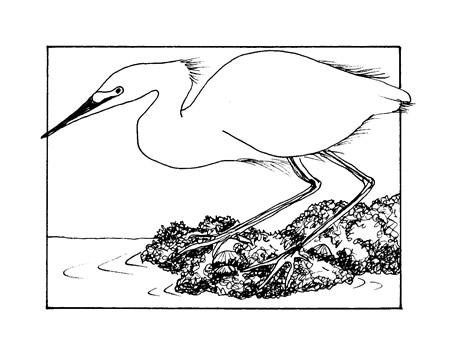Feathered Friend, a Year-Round Resident

In the late nineteenth century, snowy egrets (Egretta thula) were hunted almost to extinction for their showy breeding plumes (aigrettes), which were used in the millinery (hat) trade. This was curtailed in North America after 1910 with the passing of hunting legislation that ultimately became the Migratory Bird Treaty Act of 1918. Since then, populations have rebounded across the U.S. and today the snowy egret is one of the prettiest and showiest bird species found in Laguna Beach.
The bright white bird is two feet tall with a long, slender neck and a three-foot wingspan. With yellow eyes and a long black bill topped with yellow lores (skin between the eyes and the beak), the delicate-looking bird has long slender black legs with yellow feet tipped with black nails. Belonging to the heron family, the birds live between 12 and 18 years.

Snowy egrets have a range that extends from South America to as far north as the Great Lakes in North America. Considered partial migrants on both warmer southern coasts of the U.S., parts of Central and South America, the snowy egret can be a year round resident. In its northern distribution and away from the U.S. coasts, the snowy egrets migrate to Mexico, South America and the West Indies. Found at bodies of shallow water including marine shorelines, inlets and tidal channels, as well as freshwater ponds, swamps, marshes, mudflats and wet grassy fields, the bird generally forages mostly for fish but also crustaceans, mollusks, insects and small reptiles. Active hunters, they use a variety of techniques to capture prey including running, shuffling their feet, hopping and dip-fishing, which is dragging its feet under the water as it flies, to flush victims into the open to be ambushed, speared by their beak and eaten. Daytime foragers, they primarily eat in the early morning and early evening either alone or in small groups of birds. In Laguna Beach, the birds are year-round residents and found in the shallows at the water’s edge or in the tidepools after the summer crowds recede.
Snowy egrets can reproduce when they reach 1 to 2 years of age. During the breeding season in late spring through the summer, the Snowy egrets grow long, white, feathery plumes on their head, breast and neck and their feet and lores take on a reddish hue. Reproduction takes place in isolated estuarine habitats during late March and April. Shallow nests are usually built in colonies with other egrets and herons on the ground in thick vegetation or in trees near the water. Both parents brood the three to six bluish-green eggs for approximately 23 days. After hatching, the gray chicks are cared for by both parents for approximately three weeks, when the chicks fledge.
Predators of the snowy egret include raccoons, owls, crows, eagles, hawks, snakes and alligators. Habitat loss due to the drainage of wetlands, environmental contamination and disturbances due to human population encroachment and urban development are continuing threats. Some East Coast snowy egret populations are declining due to pollution and competition with other bird species, throughout much of the rest of its range, populations are considered stable. In Laguna, visit the tidepools in the early morning or late afternoon to increase your chances of seeing a snowy egret.
Laguna Beach supports a large number of resident bird species and in 1978 was designated a Bird Sanctuary, (Ord. 918 § 1 (part), 1978).
Residents Mia Davidson and artist Jan Sattler are year round ocean swimmers and remind you that Laguna Beach is a State Marine Reserve and it is unlawful to take or disturb the habitat and its resources.




